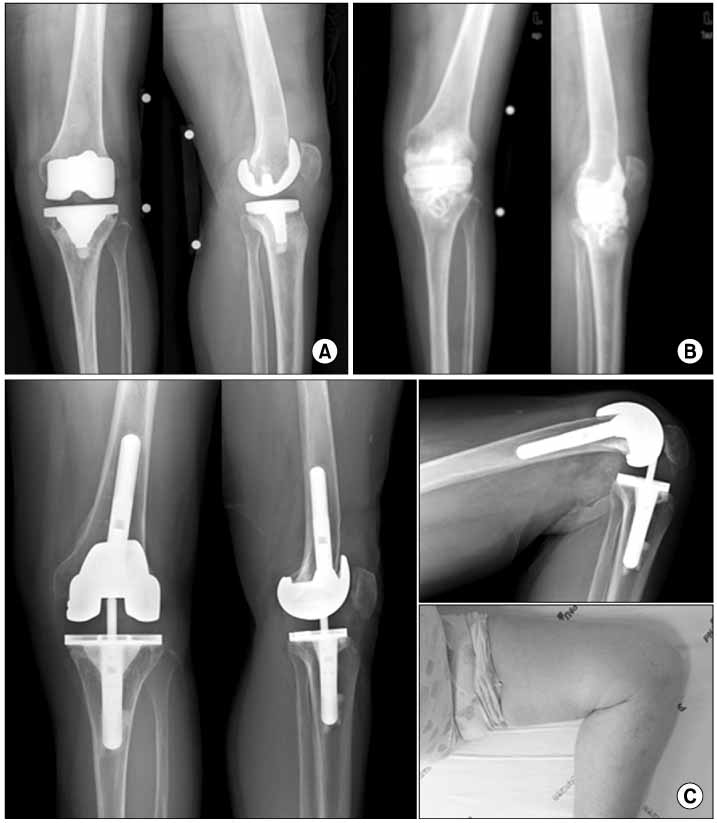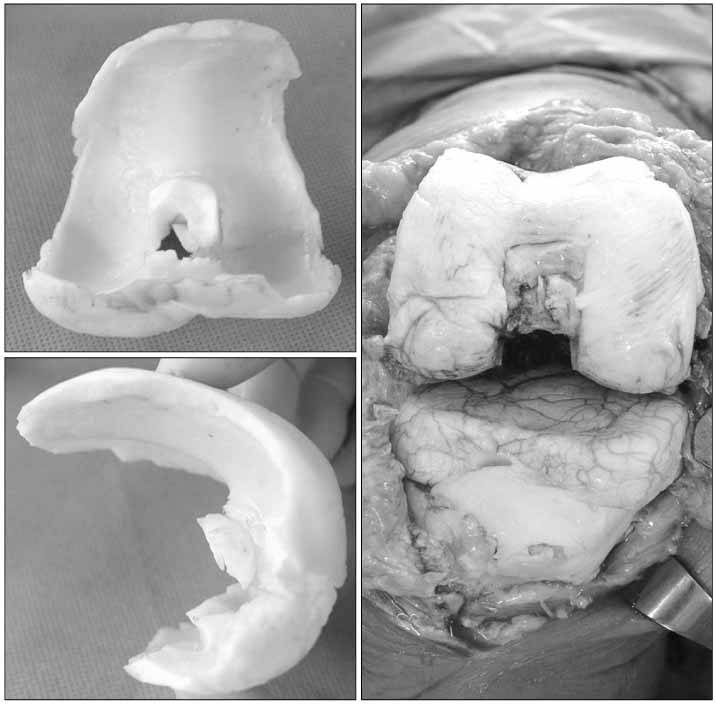J Korean Orthop Assoc.
2009 Oct;44(5):533-541. 10.4055/jkoa.2009.44.5.533.
Two-Stage Reimplantation of Infected Total Knee Arthroplasty with Antibiotic-Loaded Bone Cement Spacer: Comparison of the Types of Antibiotic-Loaded Cement Spacer
- Affiliations
-
- 1Department of Orthopaedic Surgery, Pusan National University School of Medicine, Busan, Korea. jtsuh@pusan.ac.kr
- KMID: 2186313
- DOI: http://doi.org/10.4055/jkoa.2009.44.5.533
Abstract
- PURPOSE
The treatment results of a two-stage reimplantation of infected total knee arthroplasty with either the articulating or non-articulating types of antibiotic-loaded bone cement spacers were compared and analyzed. MATERIALS AND METHODS: Between July 1995 and October 2005, this study reviewed 29 patients who underwent two-stage reimplantation of infected total knee arthroplasty and were followed up for at least 2 years. Of the 29 cases, 12 used articulating and 17 used the non-articulating type. RESULTS: Fifteen cases (52%) showed bacterial growth in the preoperative and intraoperative bacterial culture, and 14 cases (48%) had no growth. 27 cases showed no evidence of reinfection until the last follow up after two-stage reimplantation. One out of the 12 cases in the articulating group and 1 out of the 17 cases in the non-articulating group had a reinfection. The range of motion (ROM) of the knee joint and HSS knee rating scale increased more significantly in the articulating group than in the non-articulating group, and the degree of increase in the ROM of the knee joint and HSS knee rating scale was significantly larger in the articulating group. CONCLUSION: The two-stage reimplantation with an antibiotic-loaded bone cement spacer showed a 93.1% of success rate. The articulating group showed better results in the knee ROM and HSS knee rating scale than the non-articulating group
Keyword
Figure
Reference
-
1. Cui Q, Mihalko WM, Shields JS, Ries M, Saleh KJ. Antibiotic-impregneted cement spacers for the treatment of infection associated with total hip or knee arthroplasty. J Bone Joint Surg Am. 2007. 89:871–882.2. Meek RM, Masri BA, Dunlop D, et al. Patient satisfaction and functional status after treatment of infection at the site of a total knee arthroplasty with use of the PROSTALAC articulating spacer. J Bone Joint Surg Am. 2003. 85:1888–1892.
Article3. Mittal Y, Fehring TK, Hanssen A, Marculescu C, Odum SM, Osmon D. Two-stage reimplantation for periprosthetic knee infection involving resistant organisms. J Bone Joint Surg Am. 2007. 89:1227–1231.
Article4. Tsukayama DT, Goldberg VM, Kyle R. Diagnosis and management of infection after total knee arthroplasty. J Bone Joint Surg Am. 2003. 85:suppl 1. 75–80.
Article5. Bannister GC, Johnson DP. The outcome of infected arthroplasty of the knee. J Bone Joint Surg Br. 1986. 68:289–291.6. Goldman RT, Scuderi GR, Insall JN. 2-stage reimplantation for infected total knee replacement. Clin Orthop Relat Res. 1996. (331):118–124.
Article7. Whiteside LA. Treatment of infected total knee arthroplasty. Clin Orthop Relat Res. 1994. (299):169–172.
Article8. Emerson RH Jr, Muncie M, Tarbox TR, Higgins LL. Comparison of a static with a mobile spacer in total knee infection. Clin Orthop Relat Res. 2002. (404):132–138.
Article9. Fehring TK, Odum S, Calton TF, Mason JB. Articulating versus static spacers in revision total knee arthroplasty for sepsis. The Ranawat Award. Clin Orthop Relat Res. 2000. (380):9–16.10. Haddad FS, Masri BA, Campbell D, McGraw RW, Beauchamp CP, Duncan CP. The PROSTALAC functional spacer in two-stage revision for infected knee replacements. Prosthesis of antibiotic-loaded acrylic cement. J Bone Joint Surg Br. 2000. 82:807–812.11. Hart WJ, Jones RS. Two-stage revision of infected total knee replacements using articulating cement spacers and short-term antibiotic therapy. J Bone Joint Surg Am. 2006. 88:1011–1015.
Article12. Masri BA, Kendall RW, Duncan CP, Beauchamp CP, McGraw RW, Bora B. Two-stage exchange arthroplasty using a functional antibiotic-loaded spacer in the treatment of the infected knee replacement: the Vancouver experience. Semin Arthroplasty. 1994. 5:122–136.13. Pitto RP, Spica IA. Antibiotic-loaded bone cement spacers in two-stage management of infected total knee arthroplasty. Int Orthop. 2004. 28:129–133.
Article14. Hoffmann AA, Kane KR, Tkach TK, Plaster RL, Camargo MP. Treatment of infected total knee arthroplasty using an articulating spacer. Clin Orthop Relat Res. 1995. (321):45–54.15. Bae DK, Yim CM, Yang HS. Treatment of infection after total knee arthroplasty. J Korean Orthop Assoc. 1999. 34:501–508.
Article16. Bose WJ, Gearen PF, Randall JC, Petty W. Long-term outcome of 42 knees with chronic infection after total knee arthroplasty. Clin Orthop Relat Res. 1995. (319):285–296.
Article17. Hannsen AD, Rand JA, Osmon DR. Treatment of the infected total knee arthroplasty with insertion of another prosthesis. The effect of antibiotic-impregnated bone cement. Clin Orthop Relat Res. 1994. (309):44–55.18. Rand JA, Bryan RS. Reimplantation for the salvage of an infected total knee arthroplasty. J Bone Joint Surg Am. 1983. 65:1081–1086.
Article19. Insall JN, Thompson FM, Brause BD. Two-stage reimplantation for the salvage of infected total knee arthroplasty. J Bone Joint Surg Am. 1983. 65:1087–1098.
Article20. Durbhakula SM, Czajka J, Fuchs MD, Uhl RL. Antibiotic-loaded articulating cement spacer in the 2-stage exchange of infected total knee arthroplasty. J Arthroplasty. 2004. 19:768–774.
Article21. Evans RP. Successful treatment of total hip and knee infection with articulating antibiotic components: a modified treatment method. Clin Orthop Relat Res. 2004. (427):37–46.22. van Raaij TM, Visser LE, Vulto AG, Verhaar JA. Acute renal failure after local gentamicin treatment in an infected total knee arthroplasty. J Arthroplasty. 2002. 17:948–950.
Article23. Springer BD, Lee GC, Osmon D, Haidukewych GJ, Hanssen AD, Jacofsky DJ. Systemic safety of high-dose antibiotic-loaded cement spacers after resection of an infected total knee arthroplasty. Clin Orthop Relat Res. 2004. (427):47–51.
Article
- Full Text Links
- Actions
-
Cited
- CITED
-
- Close
- Share
- Similar articles
-
- Short-term Results of Two-stage Reimplantation Using Antibiotic-loaded Articulating Cement Spacer in Infected Total Knee Arthroplasty
- Role of Articulating Spacer in Two Stage Reimplantation of Infected Total Knee Arthroplasty
- Functional Outcome after Reimplantation in Patients Treated with and without an Antibiotic-Loaded Cement Spacers for Hip Prosthetic Joint Infections
- Short-term outcomes of two-stage reverse total shoulder arthroplasty with antibiotic-loaded cement spacer for shoulder infection
- Staged Reimplantation Using Cement Spacer Containing Antibiotics in Infected Total Knee Arthroplasty




